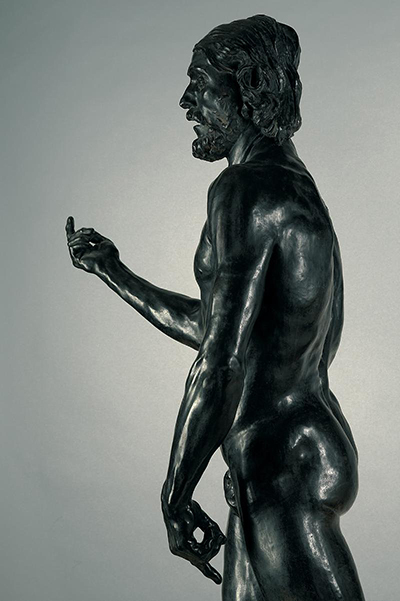Saint John the Baptist is a bronze-clad sculpture made by Auguste Rodin. Rodin started working on this sculpture in 1877. He showed the Salon of 1880 a plaster model of the sculpture.
Salon was an art exhibition held in Paris, which during the mid-1700s and late 1800s was one among the most significant biennial or annual even in the West. Between the years 1878 and 1907, the sculpture's smaller size examples were exhibited. The famous sculpture, The Walking Man, is a variant of this sculpture without the hands and the head. The Walking Man is also a Rodin creature.
Physical Attributes
Saint John the Baptist is a larger-than-life sculpture that proves it was sculpted without employing a living body and mould. The saint can be seen speaking and walking, and these organic movements are accentuated by the clearly visible muscles. Rodin's decision to display the saint with zero clothing came as a shock to the public during that period.
The artist's intention was not to grab the public's attention for the wrong reasons, but to present the human body's universal state and nature. Rodin was already acquainted with historical statues, such as the St. John the Baptist statue. Although his and the statue by Lorenzo Ghiberti have similarities, Rodin exhibits his version without St. John's traditional attributes, such as the cross and the sheepskin coat.
Ideation
The Third Republic, the period during 1870 and 1914, was a peaceful era in France. In the year 1878, a Universal Exposition or World's Fair was held in Paris through which the French government wanted to celebrate and exhibit the progress in the fields of commerce, technology, and arts to the world. The French government commissioned Auguste Rodin to come up with several public monuments. Saint John the Baptist is one of the outcomes of Rodin’s nod to the state's request.
Auguste Rodin got the inspiration for his sculpture from Pignatelli, an Italian farmworker from the Abruzzi. The man wanted to be a model. As soon as Rodin saw him, he couldn't stop himself from admiring Pignatelli's rough and hairy exterior, and the mystical attributes of his race. The external appearance of the man reminded Rodin of a man with vision, self-belief, and who is a notch above regular people. Rodin talked about his inspiration in 1913 to Dujardin-Beaumetz.
Posture and Message
Since Abruzzi was there to offer modelling services to Rodin, the latter asked him to pose for art. Abruzzi undressed himself and climbed up the revolving stand like he was posing for the first time. The peasant firmly planted himself on his feet, with this torso straight, head up, and making sure his bodyweight was borne equally by both his legs, opening like a compass. Rodin found the movement on point and quite straightforward.
Although the feet are affixed to the surface with the entire sole, akin of Egyptian sculptures, the effort entails dynamic impression that resolutely goes about its way. Rodin later explained to a friend how two phases of the man's stride were visualised simultaneously to indicate movement. It's likely that a shot of an individual walking would have the back feet raised and the right feet firmly placed on the ground, or the front feet suspended in air and the back leg firmly placed. Rodin through his sculpture wanted to present the portrayal of a walking man who is paralysis-struck and horrified in his pose.
Genre and Design Language
Romanticism started as a movement when the 18th century was nearing closure. The movement, however, was carried forward and had its biggest impact during the 19th century. The images at times communicated a story with roots in literature. In romantic sculpture, the artist tries to engage emotions of the viewer with dramatic effects created by facial movement and expression. Rodin tries to depict something similar through Saint John the Baptist. For paintings from this movement, see the work of Delacroix, Gericault and David.
Unlike Rodin's other sculptures that were unconventional for their times, this early bronze sculpture betrayed Rodin's signature elements that oozed with raw emotional and physical intensity. The saint's sunken cheeks, gouged eyes, and unkempt hair conveyed the spiritual fierceness with which he proclaims the coming of Christ. A plastered painted variant of the bust was originally showcased as free-spirited and unconstrained work during the 1879 Paris Salon. It was the first sculpture of Rodin to be part of the collection there.
On Display
Art lovers may come across examples of Saint John the Baptist in several fine arts museum across the globe, including Musee d'Orsay, Musee Rodin, Musee du Luxembourg, the Tate Museum, the Saint Louis Art Museum, the Norton Simon Museum, and the Metropolitan Museum of Art. There are several variations of this sculpture because Rodin usually made multiple versions of his creations in various sizes. One of the variants of Saint John the Baptist is a sculpture with only the head, neck and shoulders (partially). Paris' Musee d'Orsay houses another version.




